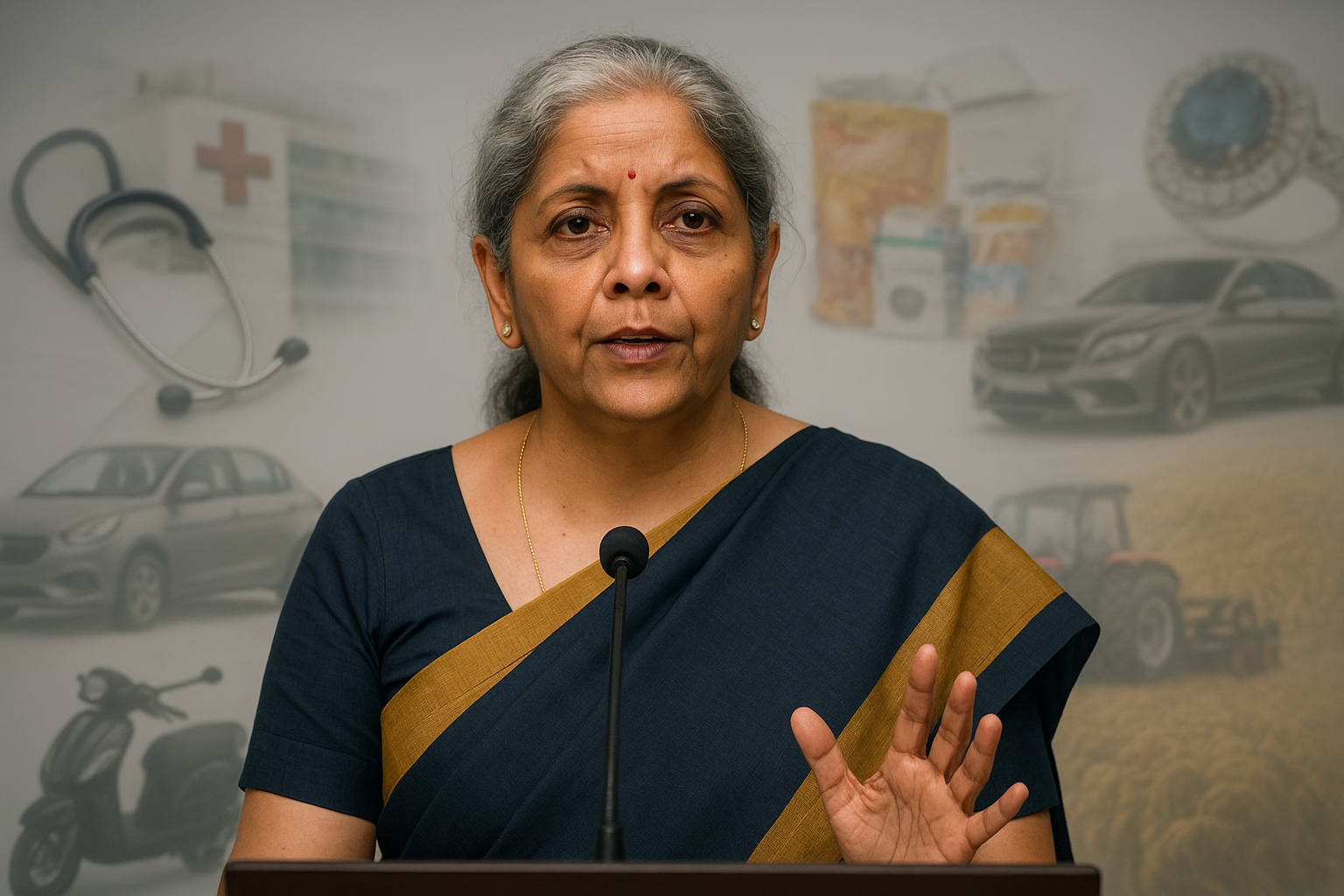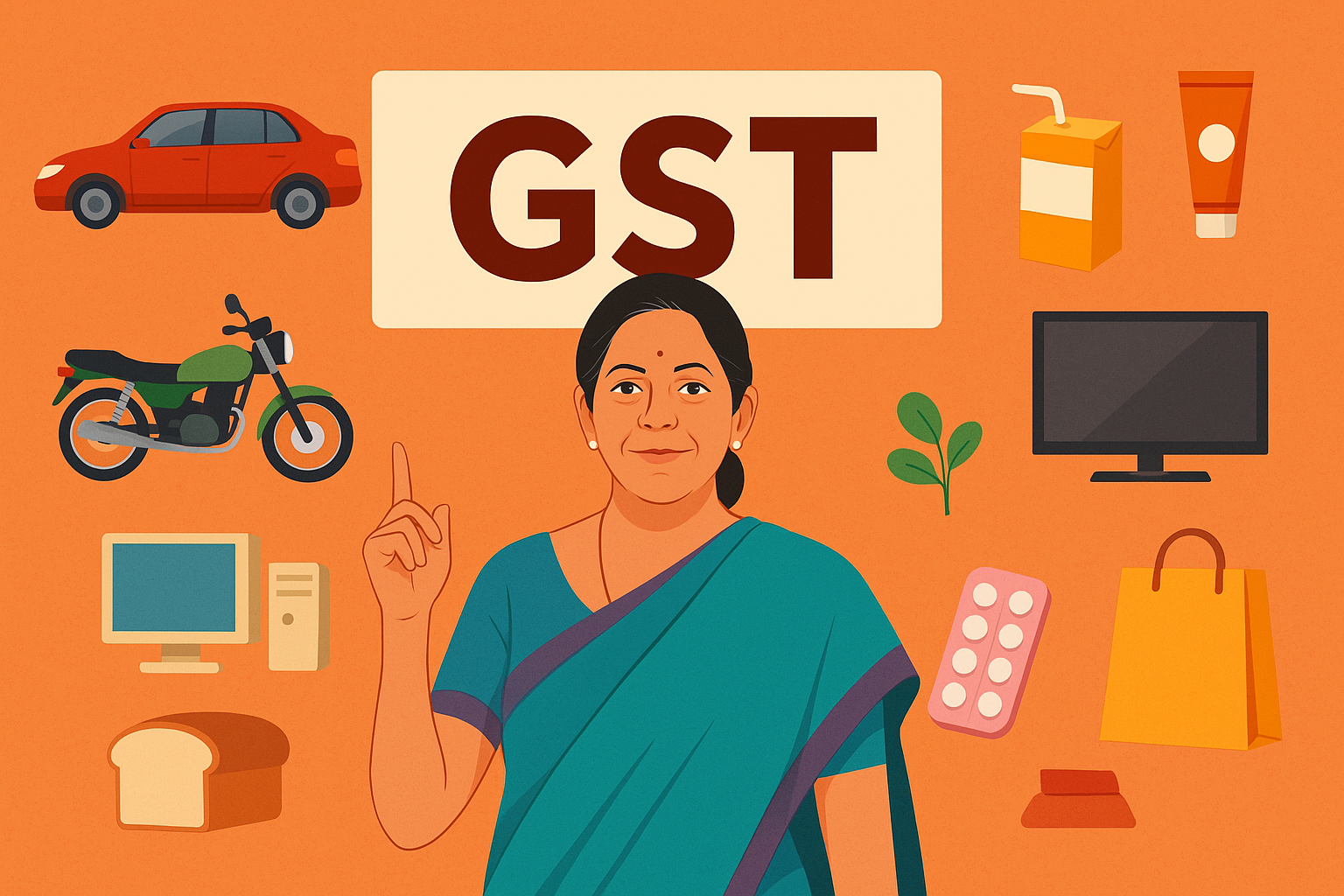Last Updated: September 4, 2025, 06:35 PM
The 56th GST Council Meeting chaired by Finance Minister Nirmala Sitharaman has brought a historic tax reform. India’s Goods and Services Tax (GST) system, which earlier had multiple slabs, is now simplified into just two main rates – 5% and 18% – along with a 40% slab for luxury and sin goods.

These changes will be effective from September 22, 2025, just ahead of the Navratri festive season. The move aims to reduce inflation, simplify compliance for businesses, and provide relief to consumers on essentials, health insurance, small cars, and electronics.
At the same time, items like tobacco, pan masala, luxury cars, and high-end products will attract a higher 40% GST, making them costlier.
This is considered the biggest GST reform since its launch in 2017, and it has already started influencing market sentiment and consumer expectations across industries.
Positive Impact Industries
Health Insurance & Healthcare
The GST Council has exempted life and health insurance from GST, bringing it down from 18% to 0%. Medicines and essential drugs also saw a big cut, reduced from 12–18% to 5%. This is a direct relief for families, senior citizens, and the entire healthcare ecosystem.
Comparisons:
- Pre-2025: Insurance at 18%, medicines at 12–18%.
- Post-2025: Insurance at 0%, medicines at 5%.
Highlights:
- Families save big on premiums.
- More people likely to buy health insurance.
- Reduced medical expenses across households.
Automobile Small Cars & Two-Wheelers
Smaller vehicles like hatchbacks and bikes under 350cc have become significantly cheaper. The GST rate has been reduced from 28% to 18%, leading to an estimated 12–12.5% price drop.
Comparisons:
- Pre-2025: Small cars and two-wheelers at 28%.
- Post-2025: Now taxed at 18%.
Highlights:
- Affordable segment cars & bikes see demand rise.
- Middle-class families benefit the most.
- Auto industry gets a sales push during the festive season.
FMCG & White Goods (Consumer Durables)
Essentials like soaps, shampoos, and toothpaste were taxed at 18%, while white goods such as TVs, ACs, and dishwashers were at 28%. The reforms have brought them down to 5% and 18% respectively, making everyday essentials and home appliances cheaper.
Comparisons:
- Pre-2025: Essentials at 18%, appliances at 28%.
- Post-2025: Essentials at 5%, appliances at 18%.
Highlights:
- FMCG items become more affordable.
- Electronics and appliances up to 8–9% cheaper.
- Strong demand expected in consumer durables.
Agriculture & Fertilizers
Fertilizers and farm machinery saw their GST reduced from 12% to 5%. This move is expected to lower input costs for farmers and support rural growth.
Comparisons:
- Pre-2025: 12% GST.
- Post-2025: 5% GST.
Highlights:
- Lower farming costs.
- Boost in agricultural productivity.
- Relief for rural households.
Negative Impact Industries
Luxury & Premium Automobiles

Big SUVs, luxury cars, and high-capacity motorcycles now face a flat 40% GST. Previously, they were taxed at 28% plus cess, reaching 45–50%. While simplified, the high rate keeps luxury prices steep.
Comparisons:
- Pre-2025: 28% + cess (~45–50%).
- Post-2025: Flat 40% GST.
Highlights:
- No major relief for premium buyers.
- Luxury demand may stagnate.
Tobacco & Pan Masala
Sin goods like tobacco and pan masala are now brought under a unified 40% GST. Earlier, these products carried uneven taxation with state levies and excise duties.
Comparisons:
- Pre-2025: Varied state + excise taxes.
- Post-2025: 40% GST.
Highlights:
- Becomes more expensive for consumers.
- Boost in government tax revenues.
High-End Electronics & Fashion
Premium apparel (above ₹2,500) and luxury gadgets now face 18% GST, compared to 12–28% earlier. This means mid-premium and luxury products are costlier.
Comparisons:
- Pre-2025: Apparel at 12%, electronics up to 28%.
- Post-2025: Unified at 18%.
Highlights:
- Costlier fashion and gadgets.
- Potential dip in premium product sales.
No Major Impact Industries
- Information Technology (IT & Software Services)
- Banking & Financial Services (excluding health insurance)
- Telecom & Internet Services
- Education & EdTech
- Real Estate & Construction
- Oil & Gas / Energy
- Pharmaceuticals (non-insurance)
- Media & Entertainment
- Logistics & Shipping
- Health Insurance, छोटे कार और Two-Wheelers पर GST कम किया गया है।
- Luxury Cars, Tobacco और Premium Products पर GST बढ़ाया गया है।
- कुछ FMCG और White Goods को भी नए slab में लाया गया है।
- Finance Ministry की official notification के बाद लागू होंगे।
- आमतौर पर अगले महीने की 1 तारीख से नई दरें लागू होती हैं।
- Premium पर GST कम होने से Health Insurance सस्ता होगा।
- Insurance penetration बढ़ने की संभावना है।
- Healthcare & Insurance
- Automobile (छोटी कारें और Two-Wheelers)
- FMCG और White Goods
- Agriculture & Fertilizers
- Luxury और Premium Automobiles
- Tobacco और Pan Masala
- High-End Electronics & Fashion
- जी हाँ, ज्यादातर household products और essential services सस्ते होंगे।
- Luxury और non-essential items महंगे हो सकते हैं।
